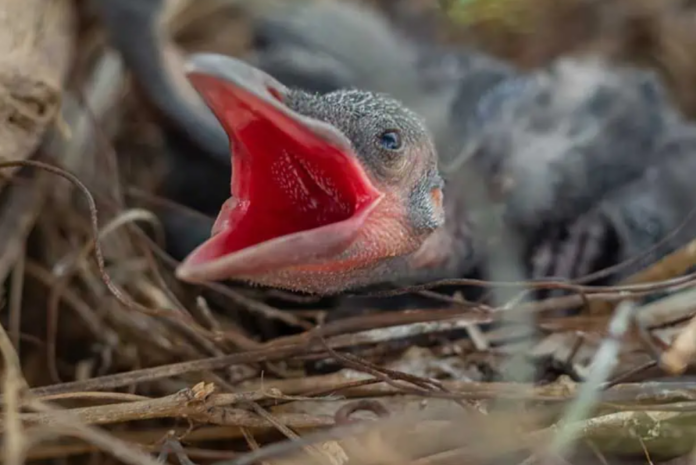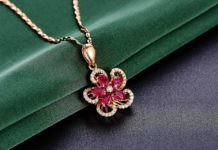BABY CROW : Do you ever know that crows did not forget a face? A baby crow is also called a chick.
Finding crows is very normal in the United States, that’s why you have noticed that the black colour birds are flying around us, in search of food or by surveying the area. Many people don’t know how does a baby crow looks like.
It mainly happens because the crow hides its nest on the upper part of a tree, when the eggs of a crow hatch the baby crow grows rapidly, and when you will see one of them, they will be like a juvenile.
If you are interested to know more about baby crow then continue reading!
Nest
A crow’s nest looks like a basket made with largely small-sized branches, animal hairs, pine needles with inner cup lined, soft barks, and weeds. The variable size of the nest is 6 to 19 inches approximately and the inner parts size is 6 to 14 inches the depth of the nest is
4 to 15 inches.
The nest of a crow is rarely used after one breeding season, if the place is liked and feel safe by the crow they might return and build their nest again at the same place for the next breeding season.
A female crow lays 3 to 9 eggs, 4 to 6 eggs are dull blue to grayish-greenish eggs which are spotted with gray and brown in color. These eggs are 1.4 to 1.9 inches long & 1 to 1.2 inches wide in size. In most cases,for almost 16 to 18 days the female crow alone looks after the eggs. The helpers and male crow used to bring food for the babies and female crow.
Sometimes the hatchlings are totally clumsy and helpless; they are completely dependent on their parents for food. They used to stay for a month in the nest.
Baby crows are unable to fly for one to two months, so they rod on the lower branch of a tree and hide themselves around the nest till the may get their strength.
Bird babies develop in stages.
Young birds are described by ornithologists—scientists who study birds—in a wide variety of terminology. These are listed according to how much the bird has grown since emerging from the egg (as birds in general do!). In terms of age, some of the oldest and most popular terms are:
- Hatchlings are newly hatched crows.
- Babies that are just a few days old and still inside a nest are called nestlings.
- Baby birds who have fledged the nest and might be acquiring flying skills are called fledglings.
- A bird is still considered to be in its hatch year if it is less than a year away from its birthday (or date of hatching).
- Young birds who don’t seem like adults and have baby feathers are called juveniles.
In general, baby birds in the nestling and hatchling stages are referred to as chicks, although fledglings are less frequently included. Chicks become fledglings when they leave the nest, sometimes before they can even fly. When young birds first moult into adult plumage, they are still referred to as juveniles. This indicates that they lose their ugly newborn feathers and grow feathers that resemble those of their species’ adults.
Precocial vs. Altricial
The divergence among altricial or precocial chicks is another significant differentiation, one that is particularly pertinent for young crows.
Young, Altricial
Whenever altricial birds hatch their babies, they look more just like newborn humans. That is, pink, soft, and completely defenceless. Have to concede that the explanation of some species of the bird altricial hatchlings as “giant gummy bears” is exact. The parents of altricial young have to tend and feed them while they stay in the nest’s security.
They are unable to open up their eyes for a few days and are not able to walk or do much more of anything. After only a few days, their feathers are just beginning to fill, giving them a distinctively scruffy appearance.
Altricial adolescents gradually fledge & transition into adult plumage, getting a little more attractive with each transition. For the first few months of their lives, babies are dependent on their guardians to provide food for their nutritional needs. Altricial offspring are born to songbirds, crows and jays, hawks and eagles, and parrots.
Premature Young
Precocial chicks are prepared to fly out of the nest immediately as they have been hatched, usually even throughout the first few hours of hatching. They hatch with silky down feathers, which adds to their cuteness, with a few very rare exceptions. Most precocial infants are squishy little puffballs by the first day of their existence outside of the womb.
They can both walk & run, which means they can leave the nest quickly. Precocial young birds have a greater probability of being seen following one of their guardians around. Nevertheless, they can quickly eat for themselves; they typically have weekly to daily feedings from their caregivers. Many game of birds, including the cranes, rails as well as birds of paradise and turkey, have precocial young.
How does a young crow appear?
When we see a baby bird it doesn’t look lovely. This same happens with crows; they are unable to prevent having altricial babies, and that’s why it is not their fault that young babies are not attractive. Just like altricial bird chicks, crows transform from ugly to fluffy when they are closer to fledging age. It is very uncertain whether they go via cute periods like precocial chicks.
CONCLUSION
In conclusion, the article has attempted to explain “BABY CROW”. I hope the language in this post is clear and understandable.
Frequently Asked Questions
Q1) What is the name of the crow’s baby?
Ans. Crow chicks are young crows. They are known as hatchlings when they first emerge from the egg, nestlings while they remain inside the nest, and fledglings after they depart. Yearling crows are young crows who have reached around a year old.
Q2) When does a baby start to crow?
Ans. Crows pair together to incubate up to six eggs, which hatch after 18 days. When the young are around one month old, they learn to fly.
Q3) Are young crows unusual?
Ans. Before they fledge, crow nestlings have virtually reached their full adult weight. Therefore, it is unusual to observe a newborn crow. A young crow might be visible near the nest or on the ground. While keeping an appropriate distance from their parents, these chicks explore their nests on their own.

















